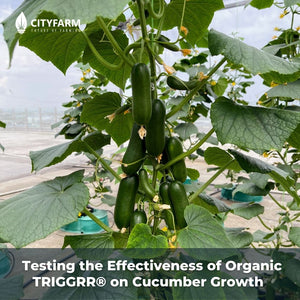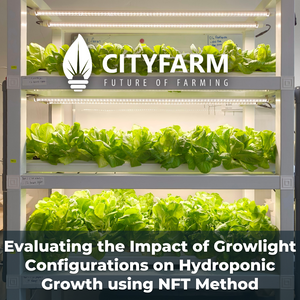[Research] Effects of Airflow on Butterhead Lettuce
![[Research] Effects of Airflow on Butterhead Lettuce](http://cityfarm.my/cdn/shop/articles/Open_Sans_Extra_Bold_32_2_1024x.png?v=1609230092)
Effects of Airflow on Butterhead Lettuce
Objectives
- To observe the effects of airflow on the butterhead lettuce.
- Determine the optimum airflow for butterhead lettuce
Introduction
The relationship between air and plants is very influential because they require carbon dioxide from the air to photosynthesize (produce food). Air movement also promotes transpiration in plants, it is a natural process in which the water travels through the plants and returns to the air. The two main functions are to decrease the temperature of the plants and deliver minerals to every part of the plants for photosynthesis (Brawner, n.d.). This is crucial to indoor farming because an enclosed space is not able to deliver natural adequate ventilation to the plants. In this case, indoor-grown butterhead lettuce usually experiences tip-burn on the inner leaves. Tip-burn is the result of deficiency of calcium, the development of necrosis on the young emerging leaves. This experiment was made to observe the effects of airflow on the butterhead lettuce and determine the volume of airflow to prevent the lettuce from getting tip-burn.
Materials
- City Vertical Farm M
- Butterhead lettuce seedlings ( 3 weeks old)
- 4ft LED T8 growlights
- Hydroponic fertilizers A and B
- pH down phosphoric acid
- Cooling fans
- Acrylic and plywood sheets
- Temperature and humidity meter
Method
This experiment was built based on the City Vertical Farm M, the 4ft NFT channels were isolated from each other using acrylic sheets to make four separated tunnels. Each tunnel was occupied with seven butterhead lettuce samples and supplied with two 4ft CityFarm Horticulture Full Spectrum LED T8 grow lights, the distance between the grow lights and the channels are 20 cm. The lighting duration was set to 12 hours in a day.


Figure 1. Photos of the modified system.
The tunnels were equipped with no fan, one fan, two fans, and three fans respectively, placing right below the grow lights at the beginning of the NFT channels. The cooling fan (12V) is 8cm long and 8cm wide, delivering 43 cubic feet per minute (CFM) or 1.22m3/ min. The fans were operating continuously for 28 days. The nutrient concentration was kept between the range of 1.3~ 1.5 mS/cm, under a pH of 6.0 ~ 6.9.

Results
Table 1: The average temperature and humidity of the four different channels.
|
|
Channel 1 |
Channel 2 |
Channel 3 |
Channel 4 |
|
Temperature (˚C) |
25.2 |
25.0 |
25.0 |
24.7 |
|
Humidity (%) |
55.6 |
54.8 |
55.5 |
56.1 |
Note. The temperature and humidity were recorded daily at 6 pm.
Table 2. The presence of tip-burn was observed during the experiment.
|
|
Sample 1 |
Sample 2 |
Sample 3 |
Sample 4 |
Sample 5 |
Sample 6 |
Sample 7 |
|
Channel 1 |
√ |
√ |
√ |
√ |
√ |
√ |
√ |
|
Channel 2 |
- |
√ |
- |
- |
- |
- |
√ |
|
Channel 3 |
- |
- |
- |
- |
- |
- |
- |
|
Channel 4 |
- |
- |
- |
- |
- |
- |
- |
Note. “√” indicates the presence of tip-burn on the butterhead lettuce samples; “-” indicates no presence of tip-burn observed. The cooling fans were located 7 inches from the first samples (sample 1), delivering air from the left (Sample 1) to the right (Sample 7).
Table 3. Weight of the Butterhead lettuce samples.
|
|
Sample 1 |
Sample 2 |
Sample 3 |
Sample 4 |
Sample 5 |
Sample 6 |
Sample 7 |
|
Channel 1 |
149g |
194g |
180g |
164g |
165g |
132g |
113g |
|
Channel 2 |
163g |
164g |
151g |
187g |
171g |
130g |
119g |
|
Channel 3 |
161g |
147g |
183g |
149g |
156g |
160g |
133g |
|
Channel 4 |
146g |
153g |
166g |
149g |
127g |
150g |
122g |
Note. The weight of the samples included the net pots and water content in the sponge.

Figure 3. Butterhead lettuce samples from Channel 1 (No fan)

Figure 4. Butterhead lettuce samples from Channel 2 (1 fan)

Figure 5. Butterhead lettuce samples from Channel 3 (2 fans).

Figure 6. Butterhead lettuce samples from Channel 4 (3 fans).
Discussion

The results were recorded on 17/11/2020. All of the samples in Channel 1 (C1) experienced tip-burn. Two out of the seven samples were experiencing tip-burn on Channel 2 (C2). There was no tip-burn observed from the samples of Channels 3 (C3) and 4 (C4). From the observations, the cooling fans were able to reduce the temperature and increase the humidity around the channels. Channels with the cooling fans (C2, C3, and C4) had slightly lower temperatures and higher humidity than the channel without any cooling fan (C1). However, the difference was not significant, the maximum difference is 0.5˚C and 1.3% of humidity. Hypothetically, the temperature decreases as the number of fans increases; the humidity percentage is directly proportional to the number of fans. But C3 with two fans had the same temperature as C2 with only one fan; C2 had lower humidity than C1 with no fans which did not match the hypothesis. The positions of the temperature and humidity meters in the channels or the defects of devices led to inaccurate readings.
Table 4. The Air Volume Flow of 4 different channels
|
Channels |
1 (No fan) |
2 ( 1 fan) |
3 ( Two fans) |
4 ( Three fans) |
|
Air volume flow rate in cubic feet per minute (CFM) |
0 CFM |
43 CFM |
86 CFM |
129 CFM |
Tip-burn on the butterhead lettuce sample is a sign of calcium deficiency, calcium is one of the minerals which deliver the top of the plants via the transpiration flow. The transpiration rate is affected by temperature and evapotranspiration (ET). The butterhead lettuce tends to undergo head formation in the center, where the head develops from the outer leaves to the inner leaves. The inner leaves had a lower transpiration rate than the outer leaves because they had limited access to the open air, which led to a deficiency in calcium, thus tip-burn occurred. The observations showed that high CFM of airflow in the channels increased the transpiration rate, so tip-burn was prevented. Further studies are required because the increased transpiration rate was assumed, and there were no results recorded on the transpiration rate. One cooling fan onwards, meaning 43 CFM or more than that greatly reduced the occurrence of tip-burn on the samples.
The air volume flow did not have a significant impact on the weight of the butterhead lettuce. However, all of the 7th samples which were located at the end of the channels were not able to form heads. The assumptions were the samples did not obtain sufficient light from the system or the samples did not obtain sufficient airflow from the beginning of the channels, causing the temperature to increase around the head forming center.


Figure 8. The Butterhead lettuce samples in the end of Channels 1 and 2. The samples failed head formation and slight tip-burn occurred.
Apart from that, the butterhead lettuce samples in channels with 2 fans (86 CFM) and 3 fans ( 129 CFM) had stunted growth during the first two weeks of the experiment. The samples’ height was maintained right below the cooling fans during that period, this might due to the overpowering airflow stressing the young samples. The samples from the channels with 1 fan ( 43 CFM) or without any fan did not experience any stunted growth.
Conclusion
From this experiment, the results showed that 43 CFM and above of airflow could reduce the occurrence of tip-burn on the butterhead lettuce. The temperature was reduced and the humidity was increased as the volume of airflow increases. This experiment is required to repeat for several times to obtain accurate results, further studies or experiments need to be done on the effects of airflow on the transpiration rate of the plants to support the hypothesis of this experiment. The cooling fans were operating for 28 days, I suggest to experiment regarding the duration of delivering optimum airflow to the plants in a day, which is important to commercial farms when it comes to electricity saving and efficiency.
References
Brawner, M., n.d. Transpiration And Why It Matters. [online] Harlequinsgardens.com. Available at: <https://harlequinsgardens.com/transpiration-and-why-it-matters/> [Accessed 20 December 2020].
- Jeffrey Chan



![[Research] The Effect of Synthetic Fertilizer and Organic Fertilizer on Plant Growth (Green ribbon)](http://cityfarm.my/cdn/shop/articles/11_69_300x.png?v=1696511389)
![[ArtIcle] Urban Farming: Opportunities and Challenges](http://cityfarm.my/cdn/shop/articles/WhatsApp_Image_2023-05-18_at_14.53.55_300x.jpg?v=1684392966)
![[Article] The Future of Indoor Vertical Farming](http://cityfarm.my/cdn/shop/articles/11_ce4d60df-c15d-4168-9051-811d2f2db016_300x.png?v=1670699733)
![[Research] The Effect of Water Temperature on Plant Growth](http://cityfarm.my/cdn/shop/articles/11_43_300x.png?v=1653919657)